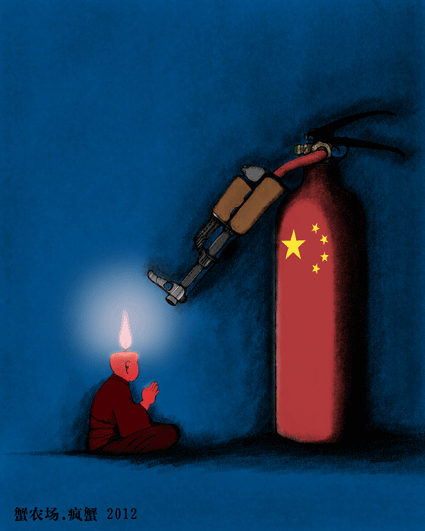
High Peaks Pure Earth has translated a blogpost by Woeser written in April 2014 for the Mandarin service of Radio Free Asia and published on her blog on April 30, 2014.
As noted before, Woeser has been a prolific and consistent commentator on the ongoing self-immolations in Tibet and this is piece can be seen as a follow up to her posts “Why do Tibetans Self-Immolate” and “Self-Immolations Are A Kind of Political Resistance”.
“Analysing Two Self-Immolation Peak Times to Understand What Tibetan People Want”
By Woeser
Looking back at the past 5 years that began with the self-immolation of monk Tapey of Kirti Monastery in Ngaba Prefecture on February 27, 2009, we see that in November 2012, self-immolations were most frequent, involving 28 men and women, young and old, monks and nuns, and many herdsmen. In March of the same year, 11 people self-immolated, including 6 monks as well as a middle-school pupil and his parents.
Why did the number of self-immolations peak during those two months?
It is because the month of March has for many years been a “sensitive month” in Tibet, full of “sensitive days”; there is March 5, the commemoration day of the suppression of the 1989 Lhasa protests; there is March 10, the anniversary of the “Tibetan National Uprising Day” in 1959; there is March 14, the anniversary of the 2008 Tibetan protests; there is March 16, the commemoration day of people from Ngaba being shot dead in 2008; finally, there is March 28, the anniversary of the so-called “Serf Liberation Day” that the Chinese government introduced in 2009. Every year, when it comes to March, the local authorities are especially cautious. Indeed, many protests have been carried out during this month. The peak of self-immolations was also March 2012, precisely during those “sensitive days”. 11 Tibetans used self-immolation as a way to express their strongest opposition against the aggressors.
November 2012, on the other hand, was exactly the time of the 18th National Congress of the CCP, producing a new generation of Party leaders. Out of the 28 people that self-immolated in November, 9 actually did during the 8 days of the Party meeting. It was more or less one per day, which illustrates that Tibetans hoped to be able to influence the Tibet policies of this new generation of leaders, turning self-immolations into a movement promoting change. Recognising this is important in understanding the motivations behind the self-immolations.
The formation of a self-immolation movement has been considered the “most powerful wave of political protest of modern times” and this despite the fact that self-immolation as a form of protest was never common in Tibetan history. Just like the 2008 protests, self-immolations were started and led by monks. Monk Tapey from Kirti Monastery who self-immolated in February 2009 was the first case within Tibet; the following 12 self-immolators were also monks or former monks who had been expelled from their monasteries by local authorities. Only in December 2012, the first case of a lay person self-immolating occurred. Out of the 20 self-immolations in the first quarter of 2012, 15 were monks. But during the second and third quarters, the number was already dominated by lay people. At the beginning of 2014, 2 out of so-far 6 self-immolations (as of late April) were committed by lay people. Until today, out of all 135 self-immolations, 47 cases involved monks and nuns, but all others were common people from different stratums of Tibetan society, including 67 herdsmen. It becomes very obvious that more and more ordinary people are throwing themselves into the self-immolation movement.
As someone recording all self-immolation incidents, whenever I am interviewed by foreign media, I always emphasise: self-immolations must never be called suicide, they are sacrifice! These kinds of self-immolations cannot be judged using Buddhist precepts, they are a result of today’s secular politics. These flames that rise high into the air again and again are ignited by the oppression of a people, they are lighting up the torch of the dark Tibet, they are the continuation of the 2008 protests, they are the continuation of what the monk from Sera monastery, the first one to bravely step forward, said: “We must stand up”! In other words, self-immolations in Tibet are a very clear form of political protest, they are nothing but that.
Whoever uses Buddhist precepts to reduce Tibetan self-immolations to suicide or even “killing”, is either ignorant or an accomplice of the Chinese government. An accomplished monk once said with regards to this: “Tibetan self-immolations do not at all violate the Buddhist doctrine of forbidding the killing of any life, neither do they conflict with the Buddhist worldview and even less can they be seen as breaking religious orders. This is because the motivation for these self-immolations does not show the slightest trace of self-interest or personal gain… their goal is to protect and maintain Buddhism, and to fight for the freedom and benefit of the Tibetan people”, they fundamentally reflect the “Bodhisattva’s way of sacrificing oneself for the benefit of others”, they are the phoenix rising from the ashes.
April 2014





Follow Us!